Knots for Rope Rails
As handsome endings for our handrails, we offer two ply and the larger three ply Manrope Knots, three variations of the sailor's eye splice, star knots, crown plaits and a range of knotted tassels.
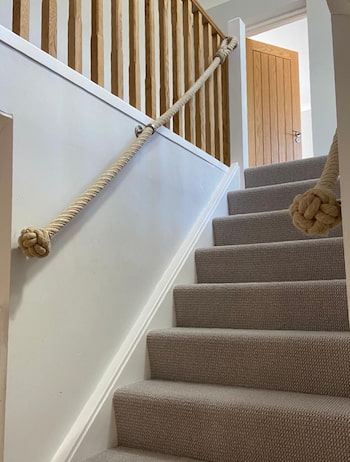
Rope stair railing in hemp wound with cotton
Photo credit: P.W., Ingatestone
The Manrope Knot
The security of a rope railing is dependent on the ending being made from the strands of the same rope; an integral knot or splice is the key to a safe and durable handhold.
The Manrope stopper knot was traditionally used on the manropes which lined stairways and walkways as safety holds and supports on board ship. Manrope knots are tied by hand using the unlaid strands of the rope.
The terms two-ply and three-ply refer to the number of times the pattern of the knot is followed around. Both versions are completely secure - constructed by unlaying the component strands of the rope and re-forming them into a permanent locking knot.
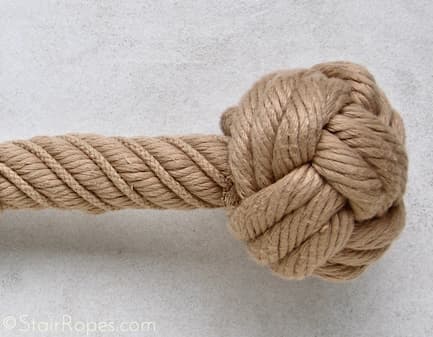
Three ply manrope knot in POSH rope
The two ply configuration of the manrope knot is compact and neat. When tied into a 24mm diameter rope, it will sit about 5cm outside the end bracket - approximately the size of a tennis ball.
The three ply manrope knot is larger and more complex and ornate in structure. A three-ply knot in a 32mm rope comes to about the size of a large grapefruit!
You can see see how the Manrope knot is tied on our Working with Ropes page.
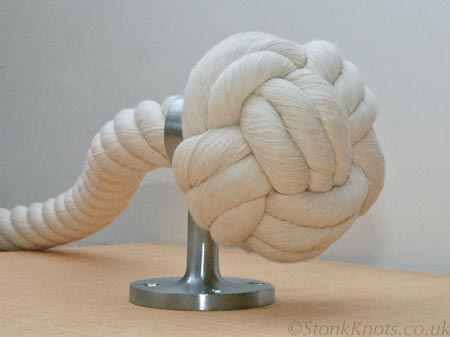
Three ply manrope knot in cotton rope
Manrope knots - Dimensions
In 24mm rope
- 2-ply: 5cm(l) x 7cm(h)
- 3-ply: 6cm(l) x 8cm(h)
In 32mm rope
- 2-ply: 7cm(l) x 9cm(h)
- 3-ply: 8cm(l) x 11cm(h)
Prices
24mm ropes
- 2-ply: £26.00
- 3-ply: £36.00
32mm ropes
- 2-ply: £33.00
- 3-ply: £42.00
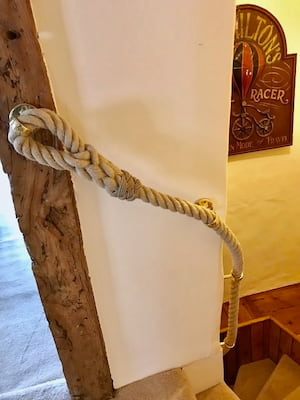
Eye splice on narrow staircase
photo credit: A.W., Bampton, Oxon
The Eye Splice
An eye splice is an alternative end knot which can fit neatly into a tricky place. It has the advantage of staying within the profile of the bracket ring and also allows the rope to be run in any direction from the wall or fitting.
We offer three types of eye splice which can be tied in one or both ends of the rope: a basic eye splice, a tapered eye splice or an eye splice with decorative Turk's head whipping.
You can use an Eye splice as a secure rope ending on a handrail in several situations where it is not possible to use the manrope end knot - for example, where the edge of the wall is too close, or if the rope needs to be run between the inside edges of newel posts.
An Eye Splice is one of the strongest and most efficient of knots, and it is proper practice to leave the strands a little proud of the rope in case the splice draws. This area can be covered with a whipping to give a neat finish.
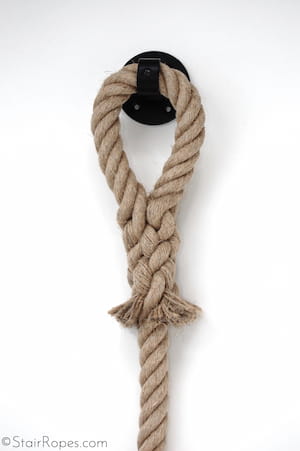
Basic Eye splice
Basic Eye Splice
The Sailor's Eye splice is a loop made in the same length of rope and joined to itself: the strands at the rope end are unlaid and tucked over and under each other back along the length of the rope. At the same time they are pulled through and worked tidily along the lay.
The basic Eye splice here shows the cut strands left visible. The strength of the splice relies on the skill of the knotter in the working of these strands, which when under tension will lock together and absorb any movement in the rope.
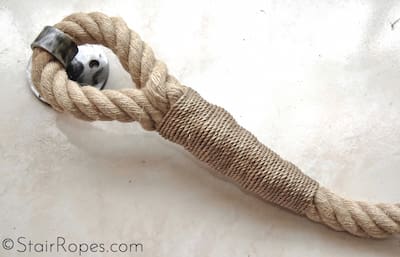
Tapered Eye splice
Tapered Eye Splice
In the Tapered splice each strand is split and cut after every tuck, thus reducing the proportion of the rope diameter along the splice.
The whole of the spliced area is then served over with a hard bound whipping.
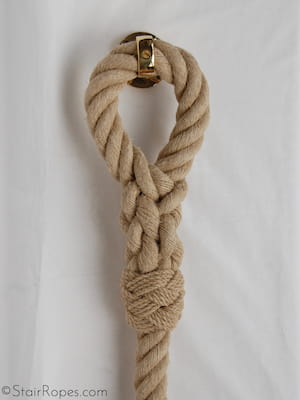
Eye splice with Turks Head whipping
The Turks Head Weave
The Turks Head is a traditional sailor's knot used here as a decorative whipping or sleeve to cover the cut ends of the eye splice.
Formed from a single length of cord, the turks head knot is woven around the main rope. The pattern in this case is followed around the rope three times. The knot is then gradually and and neatly worked tight to make a secure binding.
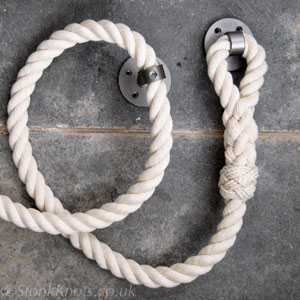

Turks Head whippings on eye splices
Eye splices - Dimensions
In 24mm rope
- Approx. 25cm long
In 32mm rope
- Approx. 30cm long
Prices
24mm ropes
- Basic eye splice: £26.00
- Tapered eye splice: £36.00
- Eye splice with Turk's head whipping: £49.00
32mm ropes
- Basic eye splice: £33.00
- Tapered eye splice: £42.00
- Eye splice with Turk's head whipping: £58.00
Decorative Rope Endings
Our decorative rope endings for handrails include crown plaits with manrope knot stoppers and a variety of knotted and plain tassels which can be ordered with combed or plaited end strands.
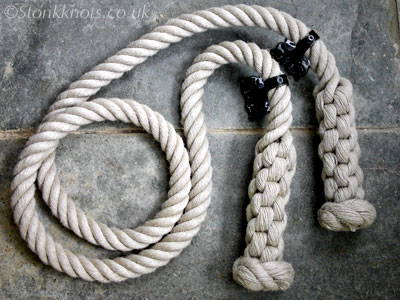
Crown and Wall End Plait with Manrope Knot Endings
The Crown Plait
A crown plait is made by building up a series of crown knots with the four unlaid strands of the rope, finishing with a 2 ply manrope knot. The plait drops down from the end bracket, making a striking decorative feature.
You can see some images of our crown plaits used as endings on the rope handrails we provided for the refurbishment of the Cromarty Historic Parish Church in Scotland.
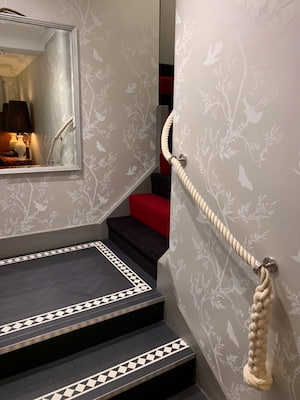
Crown and Wall Plaiting
photo credit: G. J., Glasgow.
The usual crown plait measurement on our stair ropes is approximately 450mm (18 inches), comprising 80mm (3 inches) of plain rope and 380mm (15 inches) of plaiting or braiding, including the 2 ply manrope knot, although we can also make to your requirement.
All our plaits and tassels are integral to the ropes they finish and and each rope end is locked by a cross screw in the bracket ring. For a stair rope requiring heavy or sustained use we suggest using a Manrope knot, an Eye splice or a Matthew Walker Tassel with knots set right on the bracket ring.
For further information see the installation notes below
Crown Plaiting - prices
24mm ropes
- Crown plait and Manrope knot: £49.00
32mm ropes
- Crown plait and Manrope knot: £58.00
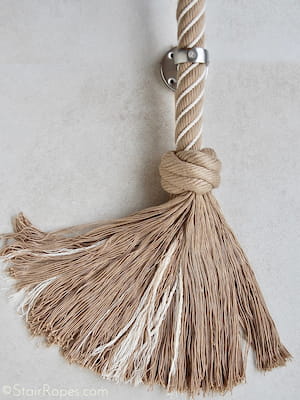
Matthew Walker tassel in wound POSH
Knotted Tassels
Depending on the type of tassel and how you want it to look, a tassel can be tied in right against the fitting or allowed to drop down beyond the end bracket fixing after a short section of plain rope.
We offer a Matthew Walker knot tassel, a Ball and Tassel and a Simple tassel, the last two each with a Turk's head whipping.
Most of our tassels can be made in hemp, cotton or POSH ropes (plain or wound) with the strands either unlaid and combed out to threads or with the threads plaited. The 3 strand polyester ropes are not suitable for tassel making.

Ball tassel in wound white cotton
The Ball and Tassel
This Ball end Tassel is created by finely combing a set of strands to threads, drawing them upward to a first stopping, then down over - which forms the ball. It is then bound with a second stopping and covered by a Turk's Head.
The finest of combed tassels are typically made from cotton rope as the fibres of this material are long and can be worked to produce the best results. Ring spun polyester (POSH) rope can be combed to almost the same degree of smoothness. The Ball tassel is available in cotton or POSH rope.
The style of a hemp tassel is more rustic (see below) as the hemp fibres are much shorter and their threads do not stand such a level of combing out.

Matthew Walker tassel in black cotton
The Matthew Walker Tassel
The Matthew Walker knot is made from a series of overhand knots and deceptively simple in structure, but to draw up neat and tight is an acquired skill.
The knot can be positioned after a short length of rope as shown here, with the tassel falling to the vertical. To give a more durable ending it can be set snug up against an end fitting (shown below in hemp).
The Matthew Walker is one of the few knots that has the distinction of being named after a person - the story goes that the sailor Matthew Walker was given a reprieve from his sentence by showing the judge a knot that the judge (himself a former sailor) could neither tie nor untie!
The Simple Tassel
A simple tassel involves unlaying the ends of the rope and securing the top of the unlaid length with a constrictor knot. This area is then whipped with a decorative Turk's Head Weave. You can choose a length for the strands and the positioning of the final bracket to suit your design.
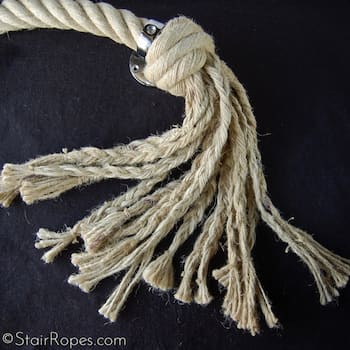
Matthew Walker tassel in hemp with knot snug up to the end bracket. Plaited strands, each tied off with a small twine constrictor knot.
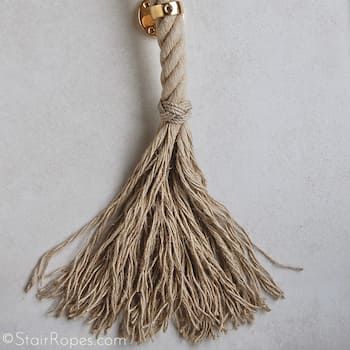
Simple tassel in hemp with a Turk's head ring whipping, positioned approximately 10cm (4 inches) away from the end fitting .
Prices
24mm ropes
- Simple tassel: £28.00
- Ball tassel: £49.00
- Matthew Walker tassel: £45.00
- Plaited threads: add £25.00
32mm ropes
- Simple tassel: £35.00
- Ball tassel: £58.00
- Matthew Walker tassel: £54.00
- Plaited threads: add £35.00
Notes
- Tassels not available in 3-strand polyester
- Ball tassel not available in hemp.
Complete Stair ropes price list on our order page
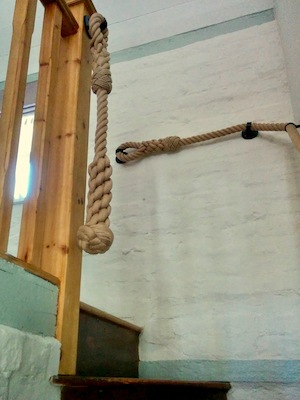
Eye splice and Crown Plaiting in POSH
photo credit: M.P., Whitchurch, Shropshire
Knots: installation notes
We take the total length measurement of a rope bannister or handrail to be the distance between the centres of the end brackets, with the two knots sitting outside this: for a two ply knot this would add approx 50mm (2 inches) at each end - for the three ply knot, 80mm (3 inches) each end.
When installing a stair rope in a restricted space where short stemmed or stemless fittings are required, consider that if using a manrope knot to tie in at the end of the rope, part of this knot will sit proud of the bracket ring, adding a further 15mm (for 24mm rope) or 25mm (for 32mm rope) to the overall projection from the wall (into the stair well).
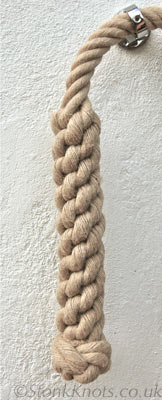
Crown and Wall Plaiting
Note that the manrope knot (and to some extent the crown plait) is incompatible with a stemless fitting, because the knot sits outside the ring of the bracket and takes up a greater width than is available between the fitting and the wall.
The minimum requirement for the 2-ply manrope knot is a short stem, and for the 3-ply manrope knot, a full stem. The eye splice ending works with any of the fittings.
To measure up for a stair rope, and for further advice on installation, see our comprehensive guide.
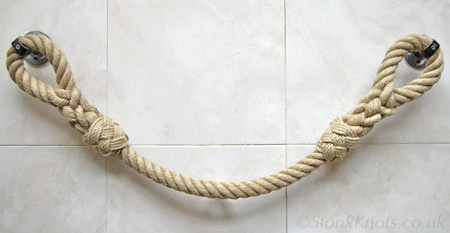
Eye splice ends with Turks head whippings on a short hemp handrail
Contact Stair Ropes.com
For more advice or information about our bannister ropes and hand rails, you can contact James Watson directly. Full details on our contact page.
All content on this website is © (copyright) 1994-2025 - StairRopes.com and Stonk Knots, unless otherwise stated.
Web site design and photography by